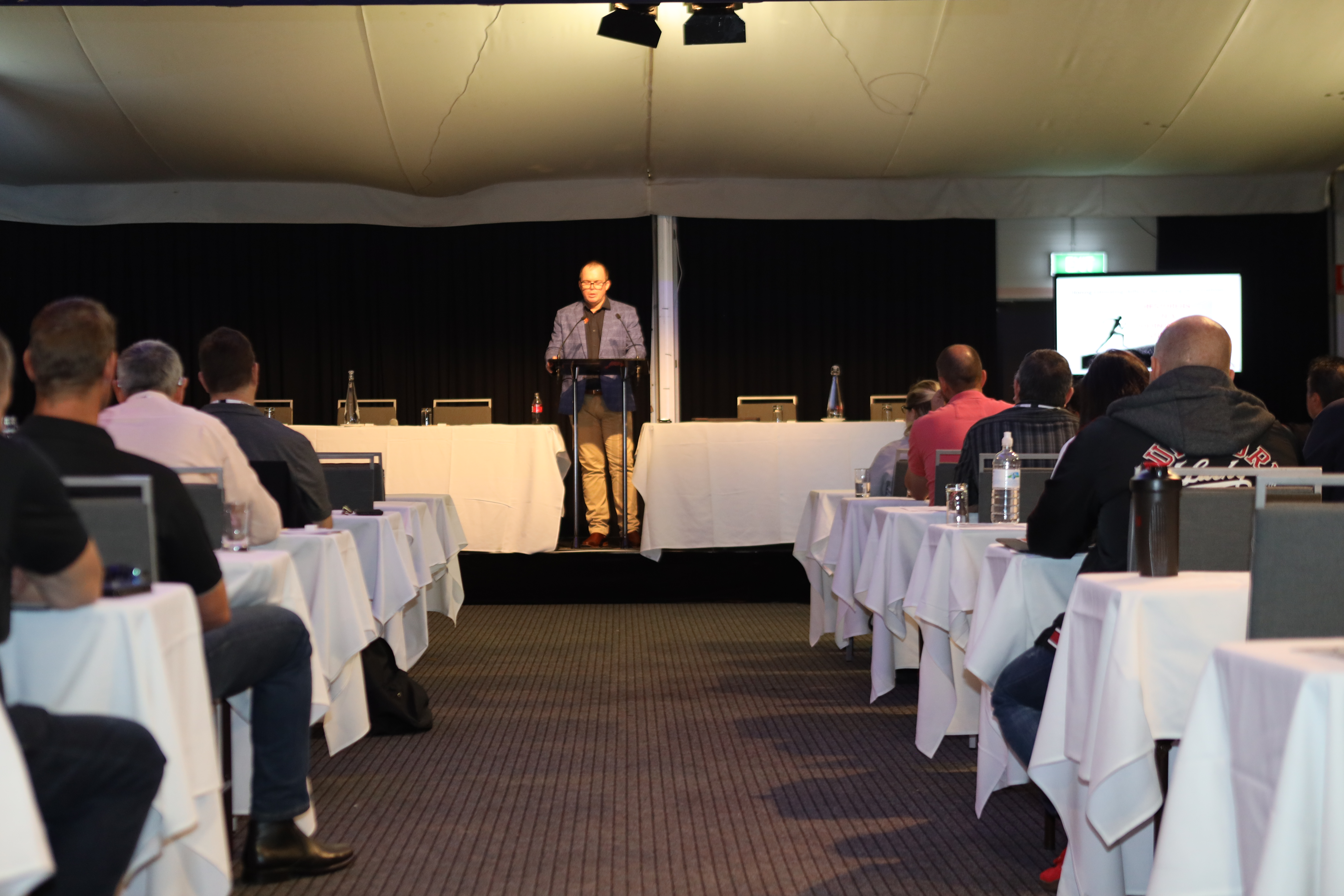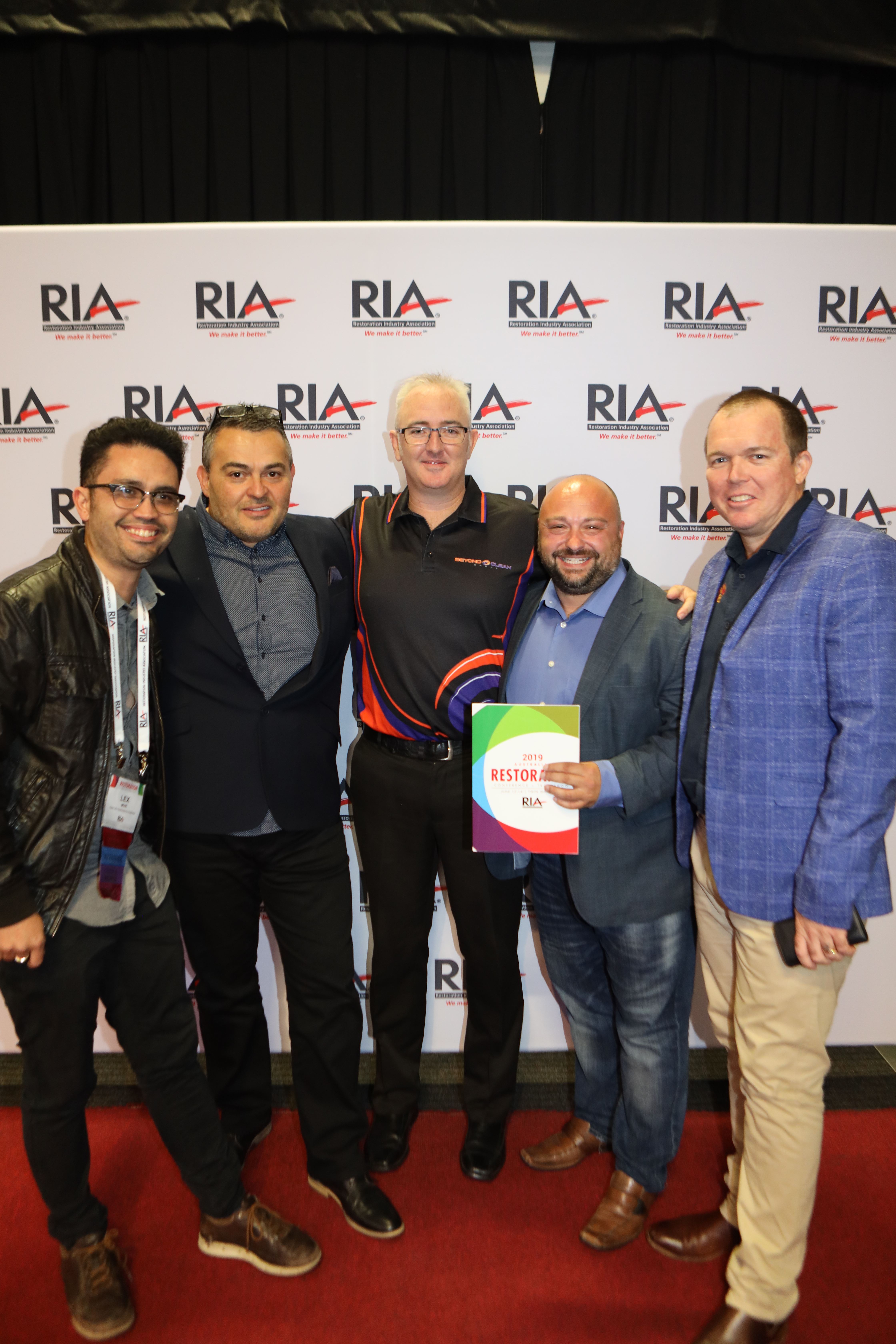Let’s Talk About Estimating
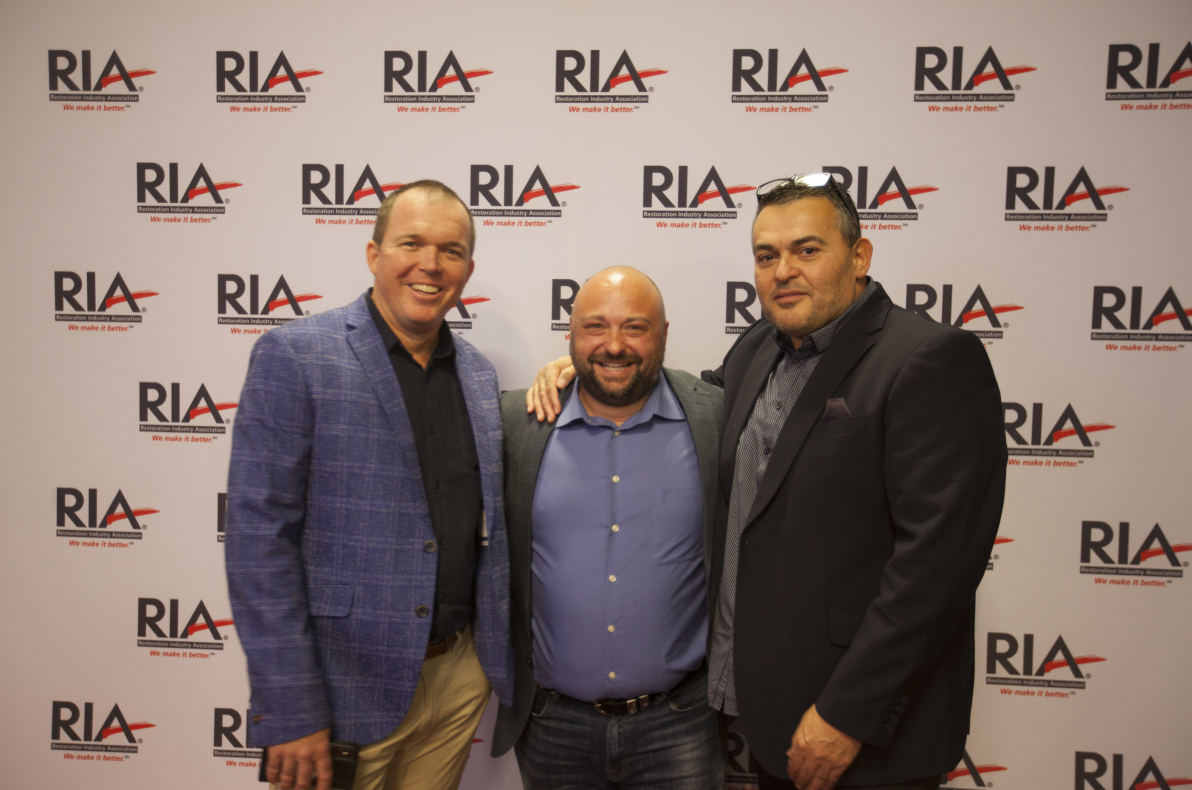
Editor’s Note: Scott McFadzen served as panel moderator. Pete Consigli served as panel facilitator, panelist reviewer and editor for the PowerPoint and panel scripts. This document is an edited version of the master script for publication in C&R magazine.
In cover image, from left: Scott McFadzen, Kris Rzesnoski and Mehmet Ucar.
Introduction
RIA’s 2019 Australian Conference & Tradeshow’s educational sessions culminated on Friday, June 14, 2019, with a diverse group of RIA members from the region and a Canadian member weighing in with varying perspectives on estimating project costs for cleaning and restoration services.
Industry adviser and RIA honorary member Pete Consigli, CR, WLS, facilitated the panel proceedings, making this a truly international panel of four Aussies, a Canuck and an American “Yank” from Florida, known as the Sunshine State. The RIA conference was held again this year in Australia’s Sunshine State of Queensland.
Consigli mentioned in his opening comments that estimating was a highly requested topic by the members, as listed in the 2018 conference evaluations. In 2018, RIA members and C&R readers might recall one of the conference highlights was a panel on Cyclone Debbie that was the cover story for C&R’s Nov/Dec 2018 issue. That panel was moderated by leading industry trainer in Australia, Scott McFadzen, WLS. He was a natural choice to follow the model established from the Debbie panel for this year’s estimating topic.
Before Consigli called McFadzen to the stage, he reinforced the importance of the estimating process, as it underlies the foundation for a profitable project secured rather than losing a bid or even losing money to complete an underestimated job.
Scott McFadzen moderating the Estimating Panel.
Meet the Panelists
Those in attendance at last year’s conference might remember we had a panel on Cyclone Debbie and how various stakeholders handled CAT loss response issues and prepared for the cyclone. Based on feedback from you, the members, this year, the panel will address the subject of estimating for projects and what technologies and best practices are being used to more successfully estimate and manage your projects.
Estimating can be a complex issue, especially on large projects, and considering the ever changing insurance industry practices, we should find faster and more effective methods of estimating.
You could liken this session to a professional athlete who is in training. An athlete to beat the best on the track trains every day, and they don’t stop until reaching their goal of being the fastest in the world. Secondly, that athlete looks closely at the best in the world.
They often analyze and imitate what the best athletes do to perform at a world-class level. They look at how they can adapt to win and what changes are required to compete at a high level to be the best.
Today, you are that athlete in training and analyzing what can you do to compete with and be considered the best at estimating project costs in your marketplace. Our panel has many years of experience in the business and has seen changes in the industry. All four bring different views and expertise to the panel, and that is why we have asked them to share their experience and perspective with you today.
Jim Bethel from Beyond Clean – Bethel is from the Noosa region. His business started as most: a carpet and tile cleaning business. With success comes challenges, and his business has grown here on the Sunshine Coast, now dealing with water damage, mold, and smoke and fire projects.
Lex Moir from New Life Restorations in Brisbane – Moir is an owner of a medium size restoration firm that has just moved into a larger facility, deals with commercial losses and has a contents cleaning division. Moir’s role as the business motivator plays a key role with his team. Moir will share how he works with the estimating team for maximum effectiveness and how the contents side of the business has been more successful by applying estimating technologies.
Mehmet Ucar from Quantum Restorations in Melbourne, Victoria – Ucar directs a medium size restoration company handling a wide range of restoration projects specializing in large commercial claims. Ucar will be talking to us today about the challenges of complex estimating on commercial losses and how his company addresses the issues.
Kris Rzesnoski from Encircle – Rzesnoski had a feature article published in the Q2 issue of C&R magazine. The article was based on his WLS research paper requirement, leading to his RIA certification as a Water Loss Specialist. Rzesnoski brings 15 of years of experience in the restoration industry and is a Certified Restorer, Contents Loss Specialist and a WLS. He is an active volunteer with our association, serving on RIA’s Restoration Council, Canadian Council Education Subcommittee and is the chairman of the Restoration Council’s Estimating Subcommittee.
Interview With Jim Bethel
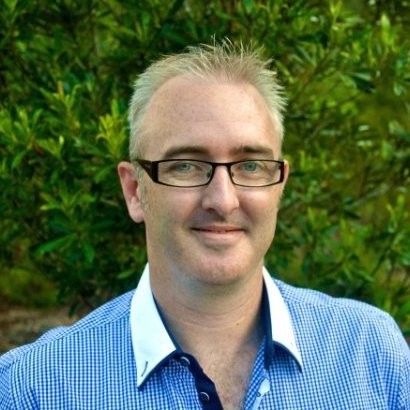 Scott McFadzen (SM): I believe when you started your business on the Sunshine Coast a few years ago, you were going to focus on tile cleaning and carpet and rug cleaning. I know you preferred tile cleaning over carpets due to the profitability of tile cleaning. How did you write an estimate on tile cleaning?
Scott McFadzen (SM): I believe when you started your business on the Sunshine Coast a few years ago, you were going to focus on tile cleaning and carpet and rug cleaning. I know you preferred tile cleaning over carpets due to the profitability of tile cleaning. How did you write an estimate on tile cleaning?
Jim Bethel (JB): Yeah, we only wanted to have a small little business here on the coast. There are almost 100 carpet cleaners here, but less than 10% of those companies had a good understanding of hard surface cleaning, and a smaller percentage had an understanding of rugs and speciality textiles. So, we preferred to do tile and grout, as the profit margins from doing tile and grout cleaning is higher than carpet cleaning, with fewer competitors. In all of our private work, we always evaluate what the material is, and, more importantly around here, what the access is.
A lot of the more affluent areas that house the clientele who could afford our services are normally up on the ridges at Buderim.
Many are perched along the dunes with extremely steep or narrow driveways that don’t entirely lend themselves to 7-meter-long vehicles. So, we never give a price over the phone. We always make an appointment and visit the site.
Apart from using the site visit to measure and quote, we have a much better closing rate after we have invested the time to chat with the client. This gives them an idea of the caliber of company they have allowed into their property or business. They can see our vehicles, our staff and knowledge that we have, so it makes the sales process more successful with a high close rate.
SM: What do you look at when you get on-site?
JB: As mentioned earlier, the actual site and access are the first thing to determine. Some vehicles have truck mounts, and some have high-pressure portables. We always try and use the truck mounts, due to how many more square meters per hour, heat and just general ease of use.
If, during the initial visit, it is a high rise or a difficult access job and we have to use a portable, this gets factored in quite simply because time is money.
After determining the most suitable type of machinery to do the job, we are then evaluating if it is ceramic, porcelain or natural stone.
We then test for any sealers or coatings that may be on either the tiles, stone or grout. We do this for two reasons:
- If we have to remove a coating from the floor, it can absorb an insane amount of time and specialty products.
- It gives us the potential for an upsell if they haven’t had it done previously or they need their existing floor resealed after the cleaning process.
Next thing we are looking at is if there are any pre-existing defects or damage on the tile, grout, cabinetry, furniture, walls or skirting. Basically, we go through with a very critical eye, as we don’t want any of their problems to become ours. A thorough inspection is a must, because if you don’t point it out prior to starting, it simply becomes an excuse later on.
Obviously, there are larger volumes of solutions being used when cleaning hard surfaces, and we don’t want to find out afterward that the client had MDF skirting boards throughout their property that could potentially absorb moisture and swell up or split.
Also, we don’t want our equipment to suck out damaged grout that we didn’t identify as previously cracked, and now they want us to re-grout their floor.
Finally, we are looking to see what the furniture levels are like in the property. We generally like to shift everything off the floors to be cleaned; however, if there are pianos, TV entertainment units or crystal cabinets, we will clean around those items.
We factor the furniture shifting into the price and then give them a price per square meter for cleaning, and always provide them with a secondary price for sealing the stone or grout lines as an optional extra.
SM: I know you don’t do much carpet cleaning now, but when you did, for a carpet cleaning estimate, do you prefer the square meterage method or the room rate as a better option? And why? Do you charge for the complete room or just the area cleaned?
JB: Just like on the Gold Coast, we have a large amount of units and tenants up here. Due to that fact, when requested to provide a quote over the phone, we just have a flat room rate for an average sized bedroom.
At that point, due to the pricing being considerably higher than most of the standard carpet cleaning firms, the caller normally gives us an “Oh, thank you, I’ll check with my partner and I’ll get back to you.” You know as they hang up you will never hear from them again, and that is fine, as quite possibly they are simply looking for the cheapest price so they can get a receipt to get their bond back.
But, surprisingly, a good amount of people that say “That’s fine, you were recommended by so and so” and ask when we can fit them in. If this is the case, we explain to them that we are happy to come and measure up in most cases. We have multiple vans running across the coast, so there is normally always one of the trucks nearby to attend a site.
SM: We know your business has changed its direction since the beginning with 95% of your business restoration focused. How do you estimate on projects these days? What do you look at? Is it time and materials based or square meterage based?
JB: The very first thing is to understand who our client is. And by that I mean who we are answering to, who is paying the invoice and where any of the interested parties fit into the food chain.
For instance, if it is a private water damage job, we might get called in by the tenant or property manager, but the homeowner is the one paying the bill and might have different requirements or requests outside the understanding of their tenant or property manager.
If it is an insurance job, understanding how to carefully and delicately escalate a job if we are being requested to do work outside of industry standards, or sometimes de-escalate a job to reduce some hysteria and bring a project back into line with industry best practices.
We use time and materials for most of our clients, as we find it the fairest method for both parties if everything can be evaluated proficiently early in the project, but leave ourselves breathing space with correct verbiage on our quotes and scope so that if something happens outside of our control that increases costs for the insurer.
We want to cover ourselves for the increase and ensure they clearly know the only reason there is a variance is due to another trade or possible delay with either the assessor or insurer while they are determining policy coverage or acceptance of the quote.
SM: Does Beyond Clean Group use any estimating tools that have assisted with the challenges of estimating on larger projects?
JB: We have an app that we have tailored specifically for us and how we operate. It allows us to scale quickly, as all the reports and scopes are done the same, no matter which staff member is onsite.
We have customised it and made it so that 99% of everything we do, be it from equipment utilized to specific step-by-step processes for any possible exercise to perform on any water damage, fire, mold or meth project is all there.
Our team members don’t have to type out the their initial processes or future steps; it is all selectable on drop-downs for them. They simply touch it and it auto-populates entire sentences, which provides us a very clear understanding of what needs to happen when providing a scope for our clientele.
If while any of the team members are on-site they aren’t sure of something — a calculation, type of category or class of water loss, construction of carpet or whatever — I have made a built in assistance section, where it has pictures and wording crafted from industry guidelines, training materials and standards. This allows us to provide uniformity across our scopes and reports.
SM: Do you have anyone in your business or perhaps a subcontractor that you can call on to assist in the process of gathering information to provide an estimate?
JB: In four years, we have had substantial growth from the early days, so it is nearly impossible that I can get to all the places weekly than previously. However, I am extremely fortunate to be surrounded by an awesome team. We have a rock star operations manager who leads by example daily for the rest of the team.
I also have been mentored by my father Gary, who rings up his 50th year in the industry this year. So, with this much knowledge in-house, it definitely helps us provide accurate scopes and estimates for our clients.
Interview with Lex Moir
 SM: You play a vital role in a medium sized restoration company in a busy city, and your part as the business developer is to provide strategies for a coherent marketing direction. In this role, you would need to be in constant connection with your estimating team. How do you train your staff to do quality estimates, and what tactics do you use to keep them focused on estimating?
SM: You play a vital role in a medium sized restoration company in a busy city, and your part as the business developer is to provide strategies for a coherent marketing direction. In this role, you would need to be in constant connection with your estimating team. How do you train your staff to do quality estimates, and what tactics do you use to keep them focused on estimating?
Lex Moir (LM): The challenge is for our project managers to complete an accurate estimate based on photographs, mud maps and an accurate report. In this case, you could not see any visual evidence of mold; however, it is quite a substantial problem!
If the estimate is not done right, you are opening yourself up to a liability claim. Many of the issues that you will face would be to do with photos and ensuring the mud map is done to a particular standard. Most of our project managers need to make an estimate based off good quality photos taken in context, thermal imaging, moisture levels, mud maps, room measurements, air quality samples, etc.
Of course, our operations team also needs to have quality information. Taking it back to the example above, how would an unqualified person know there was mold behind the kitchen cabinets? Being the CEO of the business, I cannot be on top of all the jobs, so I need to trust and empower the staff to make their own decisions.
Some comments about how we train for estimating:
- We have a tech meeting on Wednesday where we talk about projects with our team and how we completed them.
- We talk a lot about culture.
- We have core values in our training room, and we talk about them consistently. One of the things we talk about is…having ownership over the job and taking responsibility for the outcomes.
- We make sure we have open communication between the field teams and our office team. We talk about what that looks like and what it doesn't look like.
SM: I notice you travel out of your region, do you find regional pricing is often challenged?
LM: It’s not just regional; justifying costs is becoming more apparent in all areas. It’s difficult going to an area where we have no backup services or supplies. There’s costs for sending the staff up there: fatigue management, leaving and return flights every one to two weeks, accommodations, washing laundry, storage unit rentals, etc.
We have found you never really truly recover all your costs in a CAT event! In most cases, we would negotiate a CAT loading fee on each job, which takes into account all these things. If you can have the volume of work, it makes it all worthwhile.
For instance, our team can run three jobs concurrently at the same time. Also, if you can have larger commercial work happening in the background at the same time, it makes it more worth your while. Additionally, most of our clients understand the costs. It’s up to good communication on your part to negotiate a cost with the client.
SM: Do you find that synergizing with industry standards has assisted you and your estimating team in job costing projects (market research, published third-party pricing, IICRC standards)?
LM: It helps because we can scope to a standard, and we can explain why we need to do things. If anything is questioned, we can refer back to the standard. We will turn down the job if we cannot do it to the standard. That goes for mold as well. We have found that following the standard has given us a good reputation and won us good, high end, quality work. It is more profitable in the long run. It’s a long-term game.
SM: New Life has a new facility and a larger contents division. How has the installation of new processing technology helped with keeping with the pricing schedules (Ultra Sonic units)? How does your team estimate on cleaning of contents now that you have this new technology?
LM: Ultra-sonic processing is not something we use regularly; it’s not used on every contents job. However, we will use it on hard contents items, which are packed out and cleaned in our facility as opposed to on-site and stored. The efficiency of being able to process soft contents, hard contents and store on our facility creates a one-stop shop essentially, which is a good selling point. Contents is a tricky thing to get right, and we confess we do not do it right the whole time. One thing we have had to do is allocate two full-time people to manage the division, have them across the whole job and make sure the paperwork is done well. Encircle has been invaluable with contents; we use them in all our claims now. We don’t usually go toward fixed pricing per box for contents. There are too many types of different contents, soft contents and laundry. We choose to do laundry in-house as it assures the quality of the process, including complete odor removal without treatment and ozone rooms.
Interview With Mehmet Ucar
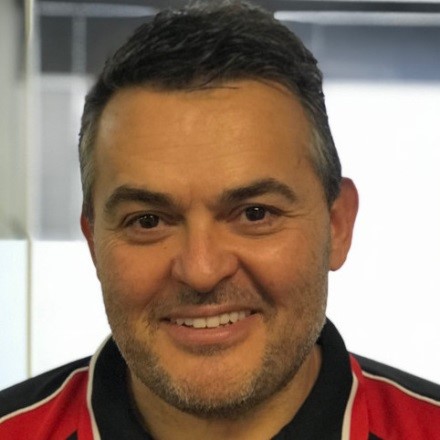 SM: You run a medium size restoration firm in a large city, and with that comes challenges with large losses. Whether they are mold, fire or water — in that context, I have three questions for you. What makes a great estimator?
SM: You run a medium size restoration firm in a large city, and with that comes challenges with large losses. Whether they are mold, fire or water — in that context, I have three questions for you. What makes a great estimator?
Mehmet Ucar (MU): The key traits of a great estimator are:
- Field experience/on-the-job experience
- Ability to read and decipher SOW and project plans
- Able to envisage the big picture and ability to visualize the project execution in their minds
- Need to be able to communicate effectively with all MIPs
- Analytical mind – able to look at project execution from all different angles
- Perseverance
- Accuracy
- Ability to multitask
- Access to well-defined processes, estimating tools and technology
SM: What general tools and processes help you and your estimators with the estimating process?
MU: The estimating tools we use are dependent on the project at hand. A restorer may use many different tools to produce an accurate estimate, and the amount of work required will vary depending on whether the SOW is defined by others or by you. The latter will potentially require a lot more effort and knowledge.
Here are some tools and processes to consider:
- Restoration process knowledge: This is usually a combination of formal training combined with field experience (i.e., IICRC, RIA or similar industry-based training, mentoring program, actually doing the job).
- Specialty tools to acquire the required information: This requirement can differ significantly depending on whether you are defining the SOW or the SOW has already been defined for you. These tools may include restoration tools such as infrared cameras, moisture meters, cameras, measuring apparatus, other data acquisition technologies, expert reports, etc.
- Pricing schedules: Defined unit pricing schedules will make the estimating process much easier. More time spent defining your project cost schedules and associated costs at the forefront will save a lot of time, and potentially money, during and after the estimating phase. The more granular the pricing schedule and SOW, the more accurate your estimate will potentially be.
- Templates: Well-defined and concise estimate templates can be the difference between a good estimate and great estimate. Spend time working on the presentation and layout of estimate templates; this work will pay off tenfold in the long run.
- Technology: There are many tools out there to help you with the estimating process; however, don’t expect to find something that will do all the hard work outlined above for you. You will still need to go through all the necessary steps above to be able to create a great estimate time after time. Software packages will make some of the above tasks a little easier and help you to get organized.
There is no substitute for hard work and good planning. As they say, there is no such thing as a free lunch.
SM: What have you learned from your years of estimating in this industry? What knowledge can you impart on some of our newer restorers that they can utilize right away?
MU: Here are some lessons learned that may be able to help the newer restorers in the room, and maybe even some of the old dogs might learn a new trick or two. In my experience, one never stops learning. Estimating is a fluid process.
Some things to consider are:
- Even though some people take to estimating more easily that others, I firmly believe that there is no such thing as a born estimator. You need to have good knowledge and experience with the task at hand to be able to estimate a project accurately.
- Use experts wherever possible. Do not included areas or tasks you do not have the required knowledge in, especially if it’s a detailed estimate or fixed priced quotation (e.g., HVAC systems, electrical systems, plumbing, etc.).
- Smaller projects where you have direct line of sight are easily estimated and controlled.
- Larger projects usually require much more time and granular SOW/estimates to ensure that you are able to meet the expectations of all stakeholders and, most importantly, turn a profit.
- A good estimate will define both the SOW and budget for the estimate. The more granular the SOW and estimate is, the easier it will be to manage the project at any given stage and ensure that you are able to turn a profit.
- Spend more time planning and devising tools to make estimating easier. Well-defined templates and pricing schedules will make the job much easier and the estimate a lot more accurate.
- Specifically exclude items that you are not pricing for. Do not assume people will know. For example, if you haven’t included cost to engage an IEP for clearance, then define it in your exclusions section.
Estimating Panelists from left: Lex Moir, Mehmet Ucar, Jim Bethel, Kris Rzesnoski and Scott McFadzen.
Kris Rzesnoski’s Presentation
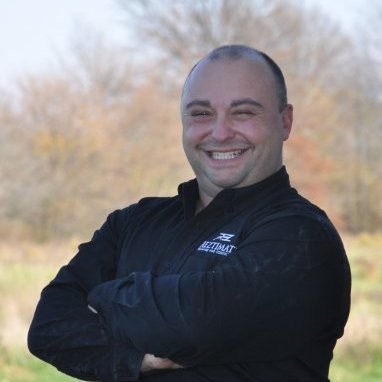 I wrote this article because restorers around the world do not take the time to understand the ramifications of the various estimating models and their impact to the restorer. Estimating has been called an art, but, in many cases, it is more like a science.
I wrote this article because restorers around the world do not take the time to understand the ramifications of the various estimating models and their impact to the restorer. Estimating has been called an art, but, in many cases, it is more like a science.
Australia has restorers exposed to some of the most aggressive and problematic systems. The question at the town hall was raised was what restorers can do to protect themselves. I would argue that you start by not signing deals that weaken your position as a professional.
You must realize your margin issues before it is too late and you lose your business to high volume and low margins.
The basis for all estimating systems is time and materials. The better term to describe this is rate and materials, because you negotiate the rates and then bill for what you use.
This is the most common system used on large loss, commercial claims and private work. You pre-negotiate the rates and the materials; labor and equipment are compensated based on usage. You still have to worry about your costs, but you can do that in a pricing model.
One would argue that time and materials is a pure method of billing a job, although your margins are locked in. You only get paid for the services you provide and are charged accordingly. The advantage is that you do not have a risk of losing money, but you also do not have the opportunity to make more than a fixed margin.
This method generally is thought of as providing the lowest margin but provides the highest security; however, when done right, the margins can be equally as high.
When using a variation of unit pricing, a restorer has to understand that there are some very strict conditions that unit pricing is applied to jobs. Unit pricing is used when you can predict the efficiencies and challenges of a job. When you have unknowns, unit pricing can become your worst enemy of the restorer. You must know or have experience pricing:
- The efficiencies of the work
- The labor costs
- The equipment utilization
- The consumable costs and utilization
- Travel, hotels, accommodations, resource allocation
Everything on the job is based off known experience, based off time and material experience, based on estimates you do on a job-by-job basis. Do you have that experience?
Unit pricing is what is most commonly used in North America on program work. When used as an estimating system, it can be an amazing system. It allows granular control of your estimating; you can control your materials costs, waste and use, labor efficiency and cost.
Each aspect of a job is micro-analyzed to determine your profit margin in a granular fashion. The risk is when used improperly or used as a price guide or pricing tool, it loses all effectiveness. It can be weaponized by those in control, which can be the contractor or can be the carrier. When one party locks down the pricing and does not allow changes to the price, it becomes a major liability to the restorer.
Square meter pricing/square foot pricing is a dangerous method of pricing. Essentially, it takes unit prices that are broken down and combines them together to create a complex square meter price. This is hard to do; only the top 5% of restorers I know do this, and it is usually on limited risk items
Equipment and consumables have to be very predictable, and you need to be able to absorb the “oops” factor.
Flat rate/room rate is the most difficult pricing model to price with, even harder to price when the pricing is set for you. You must really know your costs and know the job. These prices are set job by job because they are consistent of multiple square meter prices or unit prices.
If you are off on your estimate, there won’t be any advantage paid to you. It will be like taking a hospital kick in slow motion and watching your business get crushed. When the stars align, it can be like it is scoring one try after another try and you are a hero. But when you don’t control the rules of the game, you don’t control the flat rate, and you lose more than you win.
Rate and materials is an amazing model to work under and should not be undervalued by the restorer. When used with a scope of work, a projection of budgets and costs and formed with a plan, you can execute amazing things. You don’t know how you did if you didn’t set a goal or a budget. However, inefficiency can kill you if your competitors are faster, better trained, more efficient or more technologically advanced.
In conclusion, there are only two systems of estimating: 1) rate and materials when you don’t know or can’t predict the outcome of a price; 2) and a form of bid pricing where you make assumptions, factor in the what ifs, take the risk and should be compensated with the reward (but you also have the risk versus losses, and this cannot be underestimated).
Be aware of those who will tell you there is a magic bullet or a simple way. Estimating is hard, and there is a reason not everyone is a profitable restorer. It takes a certain skill to know how to mitigate a loss. The standard you walk by is the standard you accept, and that is true when you determine the value of your work as professionals.

